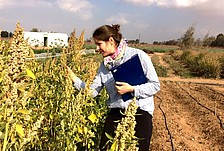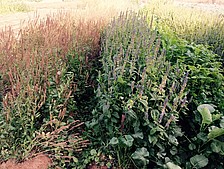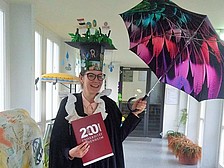Water scarcity in Egypt – improving and developing water sound cropping systems for the ancient grains “chia” and “quinoa”
Laura Mack (PhD Defence 2019)
University of Hohenheim, Institute of Crop Science, Department of Agronomy.
University of Hohenheim, Institute of Crop Science, Department of Biostatistics Unit.
Challenges
Egypt is characterized by arid climate with shotage of fresh water sources. This scarcity is expected to exacerbate the problems associated with the water sector, in terms of water quality, and quantity due to global warming and population growth with improved standards of living, and health. The standard indicator of water scarcity defines 1700 m3 per capita per year. Per capita fresh water availability in Egypt declined to 900 m3 in 2000. Agriculture consumes the largest amount, with its share exceeding 85% of the total water demand. Egypt grows an enormous quantity of crops requiring irrigation, including 7 million tons of wheat a year. Policies aim an increased efficiency in irrigation and the use of water efficient crops but earn high revenues in international markets (e.g. less wheat and cotton). Both chia and quinoa are considered to be drought tolerant and thereby requiring not more than 400 mm a-1 of water.
Objectives:
The objective of this project is to study and investigate cultivation of chia and quinoa as a solution for water scarcity in Egypt. The importance of integrating chia and quinoa as new crops in the Egyptian cropping structure requires (i) the development of sound cropping and management systems for both chia and quinoa, (ii) the assessment of interactions between drought stress, phenological response (flowering), yield parameters (seed yield, thousand seed weight), and relevant quality traits (protein and oil content, fatty acids including PUFAs (omega-3-fatty acids), amino acids, mucilage content for chia and saponins for quinoa), and (iii) the establishment of practical management and irrigation recommendations for optimization of yield, quality, and economic returns.
Aims
- Reduce water conflicts by saving the scarce source water.
- Promote a prototype cropping system including advices on the ideal ideotype of Chia and Quinoa.
- Optimization of the health benefiting compounds and yield parameters to create a new product with a nutritionally high value for human diet.
Methods
Field trials have been carried out from 2015-2016 to establish management guidelines for chia and quinoa in Egypt. Data collection was conducted in field trails on sites located at some practical SEKEM farms, ranging from sandy soils in the desert regions to clayey soils in the Nile valley.
Different treatments like a) six sowing dates (22.08.; 05.09.; 19.09.; 03.10.; 17.10. and 31.10.); b) four irrigation levels (for quinoa: irrigation was applied every 2nd, 4th, 6th or 8th day; for chia: every day, 2nd, 3rd and 4th day); and c) six locations (Adleya, Aswan, Al-Minya Al-Fayoum, Bahera, Banha, Luxor, and Wahat) were considered.
The data collection comprised a) periodical observation of growth and developmental parameters of chia and quinoa in the field; b) yield and yield parameters at harvest; and c) chemical analysis of quality traits. Chemical analysis was carried out by gas chromatography (GC), High performance liquid chromatography (HPLC) or Near-infrared spectroscopy (NIRS) depending on the respective quality parameters. The development of a suitable cropping system for chia and quinoa in Egypt will be derived out of these results.
Expected results
Chia and quinoa are expected to be established successfully in Egypt due to their drought tolerance. Thus, these crops are able to save the scarce source, water.
Recommendations for cultivation of chia and quinoa in Egypt including information on sowing date and irrigation scheduling will be made to promote a prototype cropping system and to improve yield and quality traits of chia and quinoa. There will be a selection of the ideal ideotype of each crop in terms of yield and nutritional composition.
Being drought tolerant chia and quinoa offer alternatives to increase farmers' income under arid conditions by diversifying products, hedging risk, expanding markets, increasind exports, decreasing imports, improving human and livestock diets, and creating new industries based in agricultural resources.
Publication
- Mack, L., Capezzone, F., Munz, S., Piepho, H.P., Claupein, W., Phillips, T., Graeff-Hönninger, S.,2017. Nondestructive Leaf Area Estimation for Chia, Agronomy Journal, 109, 1960-1969.
- Mack L, Munz S, Capezzone F, Hofmann A, Piepho HP, Claupein W and Graeff-Hönninge S, 2018. Sowing Date in Egypt Affects Chia Seed Yield and Quality, Agronomy Journal.
- Mack, L., Boote, K.J., Munz, S., Phillips, T., & Graeff-Hönninger, S., 2020. Adapting the CROPGRO Model to Simulate Chia Growth and Yield. Agronomy Journal, 1–19. doi.org/10.1002/agj2.20305
Delegation
- Tropentag 2015, 16th September 2015, Humboldt University Berlin.
- EcoSummit 2016, 29th August to 3rd September 2016, Montpellier.
Poster Presentation
- Gesellschaft für Pflanzenbauwissenschaften – Tagung 2016, 26th -28th September 2016, University of Gießen, Title: Landwirtschaft in der Würste – Entwicklung eines Anbau- und Bewässerungssystems für die alte Körnerfrucht „Quinoa“ in Ägypten.
Oral Presentation
- World Water Day 2017 – Colloquium, 22th March 2017, University of Hohenheim
Title: Water scarcity in Egypt– Irrigation strategies for quinoa. - Sommertagung AG Landwirtschaftliches Versuchswesen 29 th.-30 th June 2017, DLR Rheinlandpflanz, Neustadt an der Weinstraße
Title: Wie lässt sich die Blattfläche von Chia (Salvia hispanica L.) anhand mathematischer Gleichungen bestimmen?



